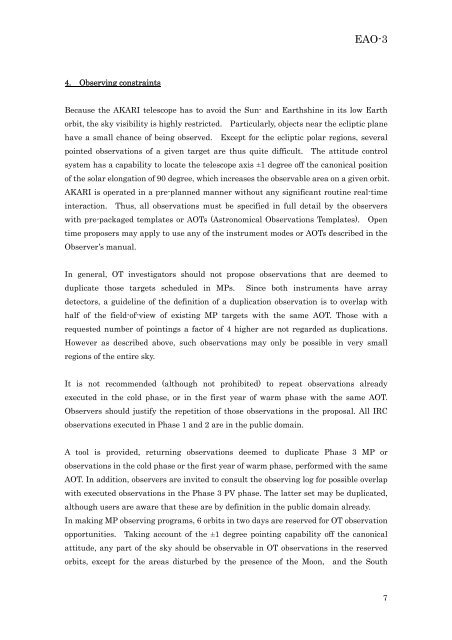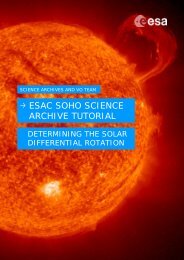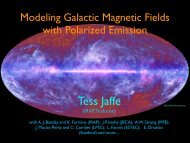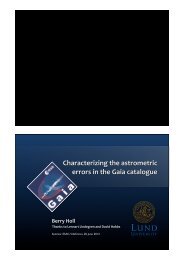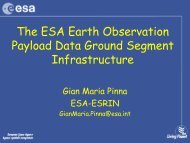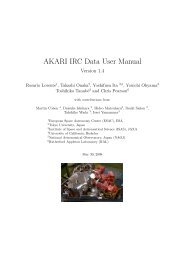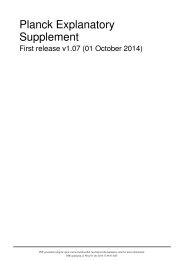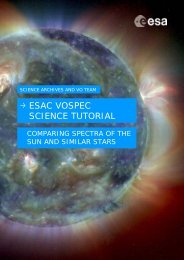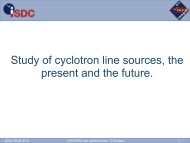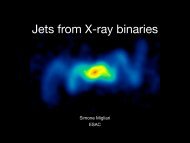1 Announcement of Opportunity AKARI (ASTRO-F) CALL FOR ... - ESA
1 Announcement of Opportunity AKARI (ASTRO-F) CALL FOR ... - ESA
1 Announcement of Opportunity AKARI (ASTRO-F) CALL FOR ... - ESA
- No tags were found...
You also want an ePaper? Increase the reach of your titles
YUMPU automatically turns print PDFs into web optimized ePapers that Google loves.
EAO-34. Observing constraintsBecause the <strong>AKARI</strong> telescope has to avoid the Sun- and Earthshine in its low Earthorbit, the sky visibility is highly restricted. Particularly, objects near the ecliptic planehave a small chance <strong>of</strong> being observed. Except for the ecliptic polar regions, severalpointed observations <strong>of</strong> a given target are thus quite difficult. The attitude controlsystem has a capability to locate the telescope axis ±1 degree <strong>of</strong>f the canonical position<strong>of</strong> the solar elongation <strong>of</strong> 90 degree, which increases the observable area on a given orbit.<strong>AKARI</strong> is operated in a pre-planned manner without any significant routine real-timeinteraction. Thus, all observations must be specified in full detail by the observerswith pre-packaged templates or AOTs (Astronomical Observations Templates). Opentime proposers may apply to use any <strong>of</strong> the instrument modes or AOTs described in theObserver’s manual.In general, OT investigators should not propose observations that are deemed toduplicate those targets scheduled in MPs. Since both instruments have arraydetectors, a guideline <strong>of</strong> the definition <strong>of</strong> a duplication observation is to overlap withhalf <strong>of</strong> the field-<strong>of</strong>-view <strong>of</strong> existing MP targets with the same AOT. Those with arequested number <strong>of</strong> pointings a factor <strong>of</strong> 4 higher are not regarded as duplications.However as described above, such observations may only be possible in very smallregions <strong>of</strong> the entire sky.It is not recommended (although not prohibited) to repeat observations alreadyexecuted in the cold phase, or in the first year <strong>of</strong> warm phase with the same AOT.Observers should justify the repetition <strong>of</strong> those observations in the proposal. All IRCobservations executed in Phase 1 and 2 are in the public domain.A tool is provided, returning observations deemed to duplicate Phase 3 MP orobservations in the cold phase or the first year <strong>of</strong> warm phase, performed with the sameAOT. In addition, observers are invited to consult the observing log for possible overlapwith executed observations in the Phase 3 PV phase. The latter set may be duplicated,although users are aware that these are by definition in the public domain already.In making MP observing programs, 6 orbits in two days are reserved for OT observationopportunities. Taking account <strong>of</strong> the ±1 degree pointing capability <strong>of</strong>f the canonicalattitude, any part <strong>of</strong> the sky should be observable in OT observations in the reservedorbits, except for the areas disturbed by the presence <strong>of</strong> the Moon, and the South7


